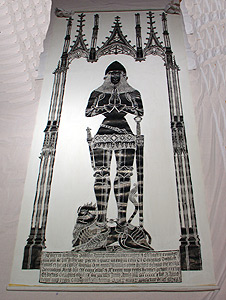Brass Rubbing: William Dalison?
1982.05.0112
Detailed Images
Basic Information
| Artifact Identification | Brass Rubbing: William Dalison? (1982.05.0112) |
|---|---|
| Classification/ Nomenclature |
|
| Artist/Maker | Kathleen H. Cairns. |
| Geographic Location | |
| Period | Medieval |
| Date | 1400 CE |
| Culture | British, English |
| Location | Not on Exhibit |
Physical Analysis
| Dimension 1 (Length) | 223.0 cm |
|---|---|
| Dimension 2 (Width) | 104.0 cm |
| Dimension 3 (Depth) | 1.0 cm |
| Weight | 376 g |
| Measuring Remarks | Under Review |
| Materials | Paper, Plant--Wood, Metal--Steel, Pigment |
| Manufacturing Processes | Rubbing |
Research Remarks
| Description | N/A |
|---|---|
| Published Description | Under Review |
| Bibliography | Cairns, Kathleen H. An Exhibition of Medieval Brass Rubbings, December 7, 1969 through January 4, 1970. Frick Fine Arts Building, University of Pittsburgh. Catalog #53. |
Artifact History
| Credit Line/Dedication | Gift of Kathleen H. Cairns |
|---|---|
| Reproduction | no |
Contact
All information about our collection is constantly reviewed and updated. Please contact Dery Martínez-Bonilla, Registrar, if there is any information you are looking for that isn't currently online.
